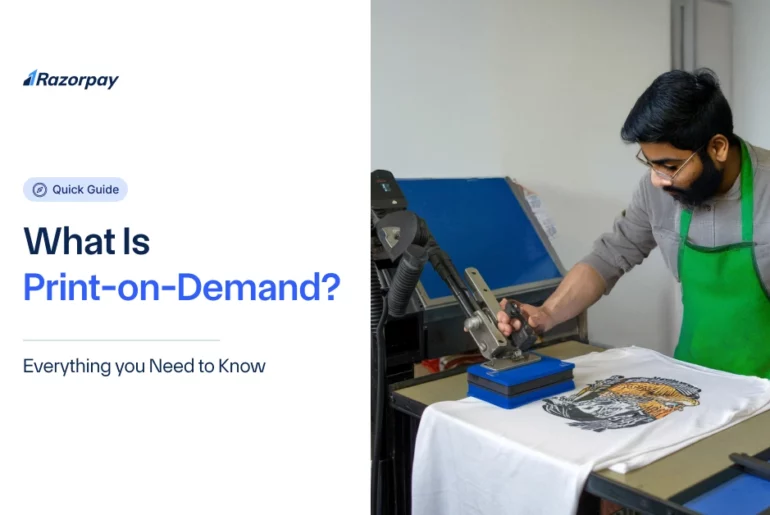Print-on-demand (POD) is a popular business model that allows entrepreneurs, artists, and ecommerce sellers to create customised products without the need for inventory or upfront costs. It works by allowing sellers to list customised products online without stocking them. When a customer places an order, the POD supplier prints and ships the item directly. This model is popular because it has low upfront costs, requires no storage, and offers a wide variety of products. Challenges include lower profit margins, limited product control, and potential fulfilment delays. POD is ideal for artists, entrepreneurs, influencers, and businesses looking to sell custom products with minimal investment.
In this comprehensive guide, we’ll explore the meaning of print on demand, how it works, its advantages and disadvantages, and how you can leverage this innovative approach to sell products online and grow your business.
Table of Contents
How Print-on-Demand Works?
The print on demand business model is relatively straightforward. Here’s a step-by-step breakdown of the process:
- Create your design: Develop unique artwork, patterns, or logos that will be printed on various products.
- Choose your products: Select the items you want to offer, such as t-shirts, mugs, phone cases, or posters, from your POD provider’s catalog.
- Upload your designs: Apply your designs to the chosen products using the POD platform’s mockup generator.
- Integrate with your online store: Connect your POD service with your ecommerce platform, such as Shopify, WooCommerce, or Etsy.
- Sell your products: When a customer places an order, the POD provider receives the order details, prints the item, and ships it directly to the customer on your behalf.
- Earn a profit: You make money on the difference between the retail price you set and the wholesale cost charged by the POD provider.
Throughout this process, the POD provider handles the production, packaging, and shipping, allowing you to focus on design, marketing, and customer service.
Pros and Cons of Print-on-Demand
Like any business model, print on demand has its advantages and disadvantages. Let’s explore both sides to help you make an informed decision.
1. Advantages of Print-on-Demand
- No inventory: With POD, you don’t need to hold any physical stock, eliminating the risk of unsold products and saving on storage costs.
- Low upfront investment: Since you only pay for products when they’re sold, you can start a POD business with minimal capital.
- Flexibility and customisation: POD allows you to offer a wide range of products and designs, catering to different niches and customer preferences.
- Scalability: As your business grows, POD can seamlessly accommodate increased order volumes without the need for additional resources.
- Time-saving: By outsourcing production and fulfillment, you can focus on other aspects of your business, such as marketing and customer service.
2. Disadvantages of Print-on-Demand
- Lower profit margins: Due to the higher per-unit costs associated with on-demand printing, your profit margins may be lower compared to traditional bulk ordering.
- Limited control over fulfillment: Since the POD provider handles production and shipping, you have less control over the process and may face challenges with quality control or delivery times.
- Shipping costs: POD products are often shipped individually, which can result in higher shipping costs for customers, potentially impacting sales.
- Competitive market: The low barrier to entry in POD can lead to a saturated market, making it challenging to stand out from competitors.
Who Can Benefit from a Print-on-Demand Business?
Print on demand is a versatile business model that can benefit a wide range of individuals and organisations. Let’s look at some examples:
1. Artists and Creators
Artists, graphic designers, and illustrators can use POD to monetise their artwork by selling it on various products without the need for inventory or upfront costs. This allows them to test the market demand for their designs and expand their reach beyond traditional art sales.
2. Ecommerce Entrepreneurs
Ecommerce entrepreneurs can leverage POD to quickly launch online stores with diverse product offerings. By using POD, they can validate product ideas, target niche markets, and scale their business without the risk of holding inventory.
3. Global Brands and Enterprises
Even established brands and enterprises can benefit from POD by using it to test new product lines, offer personalised merchandise, or cater to specific regional demands. POD’s flexibility allows these businesses to experiment with new designs and gather customer feedback before committing to large production runs.
Choosing the Right Print-on-Demand Customisation Technique
When it comes to print on demand, there are several customisation techniques available, each with its own advantages and ideal use cases. Here are the most common methods:
1. Screen Printing
Screen printing is a traditional technique that involves pushing ink through a mesh screen onto the product. It’s best suited for simple designs with few colours and large order quantities, as it requires a separate screen for each colour.
2. Direct-to-Garment (DTG) Printing
DTG printing uses specialised inkjet printers to apply the design directly onto the fabric. This method is ideal for complex, colourful designs and allows for individual customisation. However, it may not be as durable as screen printing and can be more expensive for large batches.
3. Direct-to-Film (DTF) Printing
DTF printing involves printing the design onto a special film, which is then heat-pressed onto the product. This technique offers vibrant colours, and high durability, and works well on a variety of materials, including cotton, polyester, and nylon.
4. Sublimation Printing
Sublimation printing uses heat to transfer dye onto the product, resulting in a permanent, full-colour design that won’t fade or crack. This method is perfect for all-over prints and works best on light-coloured, polyester-based materials.
Best Products for Your Print-on-Demand Business
When starting a POD business, it’s essential to choose products that align with your niche and target audience. Here are some popular product categories to consider:
1. T-Shirts
T-shirts are a staple in the POD industry, offering a classic canvas for your designs. They come in various styles, colours, and sizes, catering to a wide range of customers.
2. Hoodies
Hoodies are perfect for colder seasons and offer a cozy, fashionable way to showcase your designs. They’re popular among younger audiences and can be easily paired with other products for upselling opportunities.
3. Eco-Friendly Products
With growing environmental awareness, eco-friendly products such as organic cotton totes, reusable water bottles, and biodegradable phone cases are in high demand. Offering these products can help you attract sustainably-minded customers.
4. Stationery
Stationery items like notebooks, journals, and planners are excellent for showcasing your designs and appealing to students, professionals, and creatives alike. They also make great gift items.
5. Drinkware
Mugs, tumblers, and water bottles are practical, everyday items that offer ample space for your designs. They’re perfect for targeting coffee lovers, fitness enthusiasts, and office workers.
How to Select the Best Print-on-Demand Provider
Choosing the right POD provider is crucial for the success of your business. Here are some key factors to consider:
1. Fulfillment Methods
Look for a provider that offers the customisation techniques that best suit your designs and products. Consider their printing quality, color accuracy, and product durability.
2. Facility Locations
If your target audience is spread across different regions, choose a POD provider with multiple fulfillment centers to ensure faster shipping times and lower costs.
3. Fulfillment Times
Compare the average fulfillment times of different providers to ensure they can meet your customers’ expectations for delivery speed.
4. Product Quality
Read reviews and order samples to assess the quality of the products offered by each provider. High-quality products lead to better customer satisfaction and fewer returns.
Conclusion
In conclusion, print on demand business is a game-changing model that empowers entrepreneurs to create and sell customised products without the risk and cost of traditional manufacturing. By understanding the print on demand meaning, benefits, and best practices, you can build a thriving online business that showcases your unique designs and connects with your target audience. Whether you’re an artist looking to monetise your creativity or an ecommerce seller searching for new revenue streams, the POD model offers endless opportunities for growth and success.
Frequently Asked Questions (FAQs):
1. How do I start a Print on Demand business?
To start a POD business, choose a niche, create designs, select a POD provider, integrate with an ecommerce platform, and start promoting your products.
2. Do I need a website for Print on Demand?
While you can sell POD products on marketplaces like Etsy or Amazon, having your own website gives you more control over your brand and customer experience.
3. What file format should my designs be in?
Most POD providers accept designs in PNG, JPEG, or SVG formats. Ensure your files have a high resolution (at least 300 DPI) and are set up with the correct dimensions for each product.
4. How do I price my products?
When pricing your products, consider the wholesale cost, your desired profit margin, and the perceived value of your designs. Research your competitors and ensure your prices are competitive while still allowing for a sustainable profit.
5. Can I sell print-on-demand products without inventory?
Yes, the beauty of POD is that you don’t need to hold any inventory. The POD provider handles production and shipping only when an order is placed, allowing you to sell products online without the need for physical stock.
6. How long does print-on-demand shipping take?
Shipping times vary depending on the POD provider, product type, and shipping destination. On average, domestic orders take 3-7 business days, while international orders can take up to 2-4 weeks.
7. What is the best niche for print-on-demand?
The best niche for your POD business depends on your interests, target audience, and market demand. Some popular niches include pet lovers, fitness enthusiasts, gamers, and fans of specific music genres or TV shows. Conduct market research to identify profitable niches with low competition.




![GST State Code List & Jurisdiction 2025 [Updated List] GST State Codes](https://d6xcmfyh68wv8.cloudfront.net/learn-content/uploads/2024/02/GST-State-Codes-370x245.webp)
